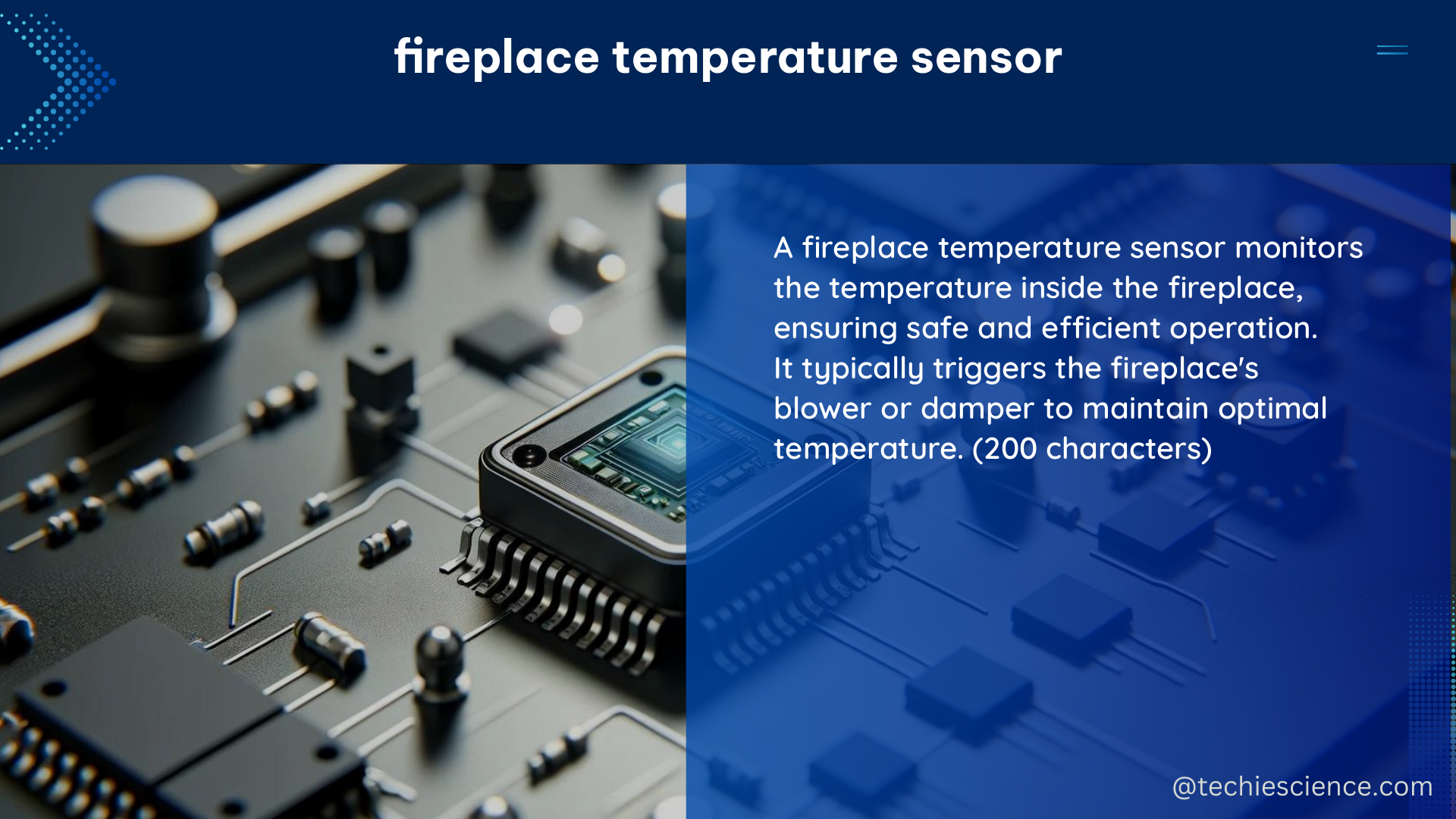The fireplace temperature sensor is a crucial component for accurately monitoring and precisely controlling the temperature of a wood-burning stove or fireplace. These advanced sensors utilize state-of-the-art thermocouple or thermistor technology to measure temperatures exceeding 1000 degrees Fahrenheit, enabling users to maintain optimal conditions for efficient and safe operation within their smart home ecosystem.
Understanding the Importance of Fireplace Temperature Sensors
Maintaining the proper temperature in a wood-burning stove or fireplace is essential for several reasons:
- Efficiency: Optimal temperature ensures complete combustion, maximizing the heat output and minimizing fuel consumption.
- Safety: Monitoring the temperature helps prevent overheating, which can lead to dangerous situations, such as chimney fires or structural damage.
- Comfort: Precise temperature control allows users to maintain a comfortable and consistent environment within their living space.
- Compliance: Many local building codes and regulations require the installation of temperature monitoring devices for wood-burning appliances.
Key Specifications for Fireplace Temperature Sensors

When selecting a fireplace temperature sensor, it is crucial to consider the following technical specifications:
Temperature Range
- The sensor must be capable of accurately measuring temperatures exceeding 1000°F (538°C) to accommodate the high-heat environment of a wood-burning stove or fireplace.
- High-end sensors can typically measure temperatures up to 2,500°F (1,371°C), ensuring they can handle the most extreme conditions.
Accuracy
- Fireplace temperature sensors should provide readings with an accuracy of ±1% or better to ensure precise temperature monitoring.
- Advanced sensors may offer accuracy as high as ±0.25% for critical applications.
Response Time
- The sensor’s response time should be rapid, typically within 1 second or less, to quickly detect and respond to changes in temperature.
- This fast response is essential for maintaining optimal combustion and safety conditions.
Durability
- Fireplace temperature sensors must be designed to withstand high temperatures, thermal shocks, and harsh environmental conditions without degradation or failure.
- Rugged construction using materials like stainless steel or ceramic is essential for long-term reliability.
Integration Capabilities
- Modern fireplace temperature sensors are often designed to integrate seamlessly with smart home systems, allowing users to monitor and control the temperature through voice commands, mobile apps, or web-based interfaces.
- Compatibility with popular home automation platforms, such as Home Assistant, Amazon Alexa, or Google Home, is a valuable feature.
DIY Fireplace Temperature Sensor Setup
For DIY enthusiasts, it is possible to build a highly accurate and precise fireplace temperature sensor using the following components:
- ESP32 Board: A powerful microcontroller like the ESP32 can serve as the brain of the system, providing connectivity and processing capabilities.
- MAX31855 or MAX6675 K-Type Thermocouple Temperature Sensor: These specialized sensors can accurately measure temperatures up to 1,800°F (982°C) with a typical accuracy of ±0.25%.
- Thermoworks K-425 Thermocouple Probe: A high-temperature, stainless steel thermocouple probe designed for fireplace and oven applications.
- ESPHome: An open-source framework that allows you to configure the ESP32 board to integrate with your smart home ecosystem, enabling temperature monitoring and control through voice commands or mobile apps.
By combining these components, you can create a DIY fireplace temperature sensor that provides precise temperature readings, fast response times, and seamless integration with your smart home setup. This customizable solution allows you to tailor the system to your specific needs and preferences.
Advanced Fireplace Temperature Sensor Features
In addition to the core functionality, some high-end fireplace temperature sensors may offer advanced features, such as:
- Wireless Connectivity: Sensors with built-in Wi-Fi or Bluetooth capabilities can transmit data wirelessly, eliminating the need for physical connections and simplifying installation.
- Data Logging: Integrated data logging capabilities allow users to track temperature trends over time, enabling better optimization and troubleshooting.
- Alerts and Notifications: Sensors can be programmed to send alerts when the temperature exceeds or falls below user-defined thresholds, helping to maintain safe and efficient operation.
- Remote Monitoring and Control: Cloud-based platforms or mobile apps can provide remote access to temperature data and allow users to adjust settings from anywhere.
- Multipoint Monitoring: Some sensors offer the ability to connect multiple temperature probes, enabling comprehensive monitoring of different areas within the fireplace or stove.
Conclusion
Fireplace temperature sensors are essential for maintaining the optimal performance, safety, and efficiency of wood-burning stoves and fireplaces. By leveraging advanced thermocouple or thermistor technology, these sensors can accurately measure temperatures exceeding 1000°F, providing users with real-time data and enabling precise temperature control within their smart home ecosystem.
Whether you choose a pre-built solution or opt for a DIY setup, investing in a high-quality fireplace temperature sensor can significantly enhance the overall experience and safety of your wood-burning appliance. By considering the key specifications and advanced features, you can ensure that your fireplace temperature monitoring system meets your specific needs and provides reliable, long-lasting performance.
References
- Smart Temperature Gauge for Wood Burning Stove
- Measuring Wood Burning Stove Filling Level
- Thermocouple-Based Temperature Measurement System for Domestic Fireplaces
- MAX31855 Cold-Junction Compensated Thermocouple-to-Digital Converter
- MAX6675 Cold-Junction Compensated K-Thermocouple-to-Digital Converter
- Thermoworks K-425 Thermocouple Probe
- ESPHome – DIY Home Automation

The lambdageeks.com Core SME Team is a group of experienced subject matter experts from diverse scientific and technical fields including Physics, Chemistry, Technology,Electronics & Electrical Engineering, Automotive, Mechanical Engineering. Our team collaborates to create high-quality, well-researched articles on a wide range of science and technology topics for the lambdageeks.com website.
All Our Senior SME are having more than 7 Years of experience in the respective fields . They are either Working Industry Professionals or assocaited With different Universities. Refer Our Authors Page to get to know About our Core SMEs.